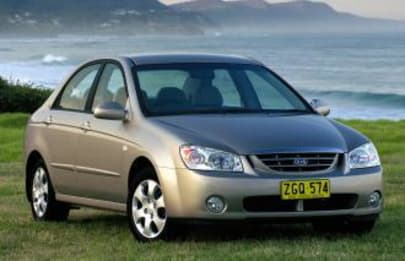
Used Kia Cerato review: 2004-2014
- Kia Cerato
- Kia Cerato 2006
- Kia Cerato 2009
- Kia Cerato 2008
- Kia Cerato 2010
- Kia Cerato 2013
- Kia Cerato 2014
- Kia Cerato 2004
- Kia Cerato 2005
- Kia Cerato 2007
- Kia Cerato 2011
- Kia Cerato 2012
- Kia Cerato Reviews
- Kia Reviews
- Kia Hatchback Range
- Kia Sedan Range
- Kia Coupe Range
- Hatchback
- Sedan
- Coupe
- Kia
- Family Cars
- Used Car Reviews
Kia Cerato is a small-to-medium South Korean model that has been overshadowed in the past by its big brother Hyundai's i30 and Elantra (Kia is controlled by Hyundai these days). However, when the ultra-stylish third-generation Cerato was launched in Australia in April 2013 buyer interest increased. Sales lifted immediately and quite a few of the third generation cars are starting to appear on the used-car scene.
The South Korean car makers are coming up with some excellent lines, and the Cerato is arguably up with the best of them. Interestingly, much of the design work is being done by Europeans.
The Cerato first arrived in Australia in July 2004, these earlier models were the first to really benefit from Kia's determination to improve build quality and are generally trouble free if they have been driven and serviced correctly.
As well as improving quality, Kia Cerato also continued the Korean marque's emphasis on the sort of good on-road behaviour that appeals to Australian drivers. The first two generations were good without being great, the third generation car is almost up with the Europeans' driving dynamics. The suspension is reasonably supple, although rough Aussie country roads can occasionally trouble it. Noise and vibration are well damped, particularly in the latest model.
Kia Cerato is sold as a four-door sedan and five-door hatch. The sedans were often introduced before the hatches so there was on overlap of new and old bodies at times.
Though it's technically listed as a small car in Australia, the Cerato is actually pretty large and interior space is good. There are no headroom problems front or rear. It also passes the four-adult test for rear legroom without those in the front seats having to compromise to any real extent. As is usually the way in this class in Australia, the Cerato is generally used by families with small children, something it handles with ease.
Most Kia Cerato models are powered by a 2.0-litre four-cylinder petrol engine. This gives it enough power and torque for most owners, but some would like a bit more grunt to match the dynamics of the chassis, particularly on the most recent model.
The Cerato from April 2013 has a new design 1.8-litre engine in place of the old 2.0. It provides more performance and uses less fuel whilst doing so. Definitely our pick of the powerplants if your budget is up to it.
Five-speed manual gearboxes were used until they were replaced by a modern six-speed unit late in 2010. The latter is an excellent unit with a good feel through the lever and a wise choice of ratios.
Four-speed automatic transmissions, fitted prior to March 2011, do a reasonable job, but you will find them hunting up and down for the best ratio at times. Far better is the six-speed auto, installed from 2011.
Kia Ceratos have quite a simple mechanical layout and can be serviced and repaired by good amateur mechanics. Don't forget to buy a workshop manual.
Spare parts and professional repair costs are reasonably priced.
Kia dealers are mainly in metropolitan areas, but some of the bigger country towns now also have agents.
Insurance is usually costed in the bottom third of the premium scale and we haven't seen any big variations from company to company. However, it's always worth shopping around, just make sure your making a fair comparison.
While the Kia Koup, introduced in September 2009 carries Cerato badges it is generally regarded as a different model. It's an interesting car with an unusual shape and we love the fact it's called a Koup rather than a Coupe.
What to look for
Former crash damage usually shows up as ripples in body panels, colours that don't match correctly and even wheels out of alignment. If you're in the least bit unsure call a professional.
Look for body damage in areas such as the rear bumper which often gets scarred by people carelessly resting stuff on it while loading the boot.
Check that the engine starts easily and idles smoothly pretty well straight away. Ideally the engine should be started stone cold first thing in the morning.
Gearboxes that are noisy and/or sticky in their changes may be due for major repairs.
Automatics should go into gear almost at the moment you move the selector.
Handbrakes can be over adjusted causing premature pad wear on the rear brakes. You may feel and hear the pads rubbing slightly on the discs during your test drive.
Fuel remote release cables can stretch making it difficult to open the flap.
Some Ceratos had audio unit failures, check the full range of modes in the system to be sure everything works correctly.
Incorrectly serviced variable valve timing units can fail due to poor oil quality blocking the oil passage. As always, we suggest having a vehicle serviced by a professional, preferably one with people trained on the vehicle type.
Pricing
| Year | Price From | Price To |
|---|---|---|
| 2014 | $6,600 | $18,370 |
| 2013 | $5,610 | $16,830 |
| 2012 | $4,730 | $13,090 |
| 2011 | $4,070 | $10,890 |
| 2010 | $3,740 | $9,680 |
| 2009 | $3,190 | $9,350 |
| 2008 | $2,750 | $4,730 |
| 2007 | $2,640 | $4,070 |
| 2006 | $2,420 | $4,070 |
| 2005 | $2,310 | $4,070 |
| 2004 | $2,310 | $3,850 |
Pricing guides
Range and Specs
| Vehicle | Specs | Price* | |
|---|---|---|---|
| (base) | 2.0L, ULP, 5 SP MAN | $2,310 – 3,630 | 2004 Kia Cerato 2004 (base) Pricing and Specs |
$2,420
Lowest price, based on third party pricing data











